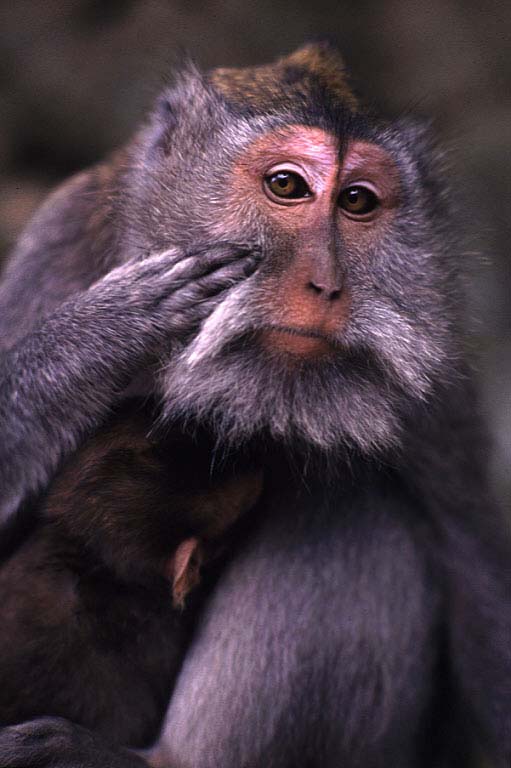
MORPHOLOGY:
This species has cheek pouches to
carry food in while it forages. The average body mass for an adult male
crab-eating macaque is around 6 kilograms, and for the females it is
around 4 kilograms. The tail on this species is quite long.
RANGE:
The crab-eating macaque is found in
the countries of Brunei, Burma, Cambodia, Indonesia, Laos, Malaysia,
Philippines, Thailand, and Vietnam. This species is found in a variety of
forest habitats throughout its range, it especially prefers edge habitats.
ECOLOGY:
The crab-eating macaque is a frugivorous
species, but will also eat leaves, insects, grasses, seeds, flowers, buds,
shoots, gum, sap, and bark. This species will also raid crops and eat the
food such as rice and taro plants. It will also forage for plant species
located near water (Richard, 1985). The average group
size for the crab-eating macaque is 30 individuals. This species is mostly
arboreal,
spending much of its time in the forest canopy,
but it occasionally comes down to the ground. This is a diurnal
species.
LOCOMOTION:
The crab-eating macaque is a quadrupled
species (Fleagle, 1988). This species sometimes swims in lagoons or rivers
(Richard, 1985).
SOCIAL BEHAVIOR:
The crab-eating macaque has a multi
male-multi female social system. Females remain in their natal group with
the onset of maturity, but males will disperse
shortly before adolescence. There is a hierarchical system amongst group
members based upon the matrilineal. The mating system for the crab-eating
macaque is a promiscuous system, but most of the mating is done by an
alpha male. Males will sometimes form affiliations with same age males
from their natal group. Both males and females are aggressive during inter
group encounters (Angst, 1975).
VOCAL COMMUNICATION:
Olfactory communication:
Visual communication:
fear grimace:
The lips are retracted so that the teeth are shown; the teeth are clenched
together (Estes, 1991). This display functions as an appeasement signal to
reduce aggression
in aggressive encounters (Estes, 1991).
staring with open mouth: This is the stare accompanied by the mouth
being open but the teeth are covered (Estes, 1991). This is a threat
expression (Estes, 1991).
Tactile communication:
REPRODUCTION:
The crab-eating macaque gives birth
to a single offspring.
REFERENCES:
Angst, W. 1975> Basic Data and
Concepts in the Social Organization of Macaca fascicularis. in Primate
Behavior, vol. 4, ed. L.A. Rosenblum. Academic Press.
Burton, Frances. 1995. The Multimedia Guide to the Non-human Primates.
Prentice-Hall Canada Inc.
Estes, R.D. 1991. The Behavior Guide to African Mammals. University
of California Press.
Fleagle, John G. 1988. Primate Adaptation and Evolution. Academic
Press.
Richard, A.F. 1985. Sympatry, Competition, and the Niche. In Primates
in Nature, ed. A.F. Richard. W.H. Freeman and Co.